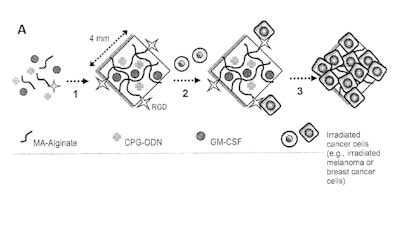Innovations in engineered slippery surfaces, drug delivery, antibiotic susceptibility testing and more
To realize its overarching goal to invent and commercialize disruptive solutions for healthcare, energy, architecture, robotics, and manufacturing, the Wyss Institute is creating a patent portfolio in relevant areas that are or can become an essential basis for specific business development and commercialization efforts. To learn more about these innovations, contact our Business Development Team.
The Wyss Institute’s U.S. patents issued between April and June 2017 are as follows:
Elastic hydrogel
U.S. Patent 9,688,741 (June 27, 2017)
Nasim Annabi, Anthony Steven Weiss, and Ali Khademhosseini
Abstract: The present invention relates to hydrogels and to the use of hydrogels for repair or restoration of tissue. In particular, the hydrogels of the present invention can be used for the repair or restoration of cardiac tissue.

Foldable machines
U.S. Patent 9,686,867 (June 20, 2017)
Daniela Rus, Robert J. Wood, Cagdas Denizel Onal, and Michael Tolley
Abstract: Methods to systematize the development of machines using inexpensive, fast, and convenient fabrication processes are disclosed. In an embodiment, a folding pattern and corresponding circuit design can provide the blueprints for fabrication. The folding pattern may be provided (e.g. laser machined) on a flat sheet of substrate material, such as a polymer. The circuit pattern may be generated by etching or applying (e.g. sputtering) a copper foil layer onto the substrate. Circuit components and actuators may then be added at specified locations. The flat substrate may then be folded along the predefined locations to form the final machine. The machine may operate autonomously to perform a task.
Dynamic and switchable slippery surfaces
U.S. Patent 9,683,197 (June 20, 2017)
Joanna Aizenberg, Benjamin Hatton, Xi Yao, Michael Aizenberg, and Wendong Wang
Abstract: The present disclosure describes a strategy to create self-healing, slippery liquid-infused porous surfaces (SLIPS) that can be modified as desired. Roughened (e.g., porous) surfaces can be utilized to lock in place a lubricating fluid, referred to herein as Liquid B to repel a wide range of objects, referred to herein as Object A (Solid A or Liquid A). Use of an external stimuli or degradation of the Liquid B can be utilized to change the characteristics of SLIPS structures reversibly or irreversibly that may be desired in a number of different applications. Numerous characteristics, such as adhesion, optical, mechanical, and the like, can be dynamically changed.
D, L-cyclic peptide nanotube reinforcing agents
U.S. Patent 9,682,168 (June 20, 2017)
Neel Satish Joshi and Daniel James Rubin
Abstract: The disclosed subject matter can provide a nanotube-reinforced polymer composite material comprising a plurality of nanotubes, each nanotube being formed of a plurality of cyclic peptide molecules, disposed within a polymer matrix, such as a biodegradable polymer matrix. A cyclic polymer, such as a cyclic 8-mer, composed of amino acid residues of alternating absolute configurations (D/L, R/S), can self-assemble into nanotubes useful for preparation of the composite polymer material of the invention. For example, the cyclic peptide (QL)4, wherein the glutamine and leucine residues are of opposite absolute configuration, self-assembles into nanotubes, which when formed into a reinforced polymer composite including poly(caprolactone), provides a biocompatible material of greater tensile strength and Young’s modulus compared to the poly(caprolactone) material alone. The nanotubes can be prepared by a vapor equilibration technique or by a solvent-nonsolvent precipitation technique. The materials of the invention can be used for implants, stents and the like as well as for synthetic ligaments, tendons, cartilage, and bone for use in the living tissue of a patient in need thereof. For example, a spinal fusion cage comprising a PDLLA polymer matrix with a plurality of nanotubes of the invention can exhibit enhanced stiffness.

Injectable cryogel vaccine devices and methods of use thereof
U.S. Patent 9,675,561 (June 13, 2017)
Sidi A. Bencherif, Roger Warren Sands, Sandeep T. Koshy, and David J. Mooney
Abstract: The invention provides polymer compositions for cell and drug delivery.
Self-regulating chemo-mechano-chemical systems
U.S. Patent 9,651,548 (May 16, 2017)
Joanna Aizenberg, Ximin He, and Michael Aizenberg
Abstract: A chemo-mechano-chemical (C1-M-C2) system includes a base supporting an actuatable structure, said structure comprising a functionalized portion and being embedded in an environmentally responsive gel capable of volume change in response to an environmental stimulus; a first fluid layer disposed over the base and in contact with the actuatable structure, said first fluid layer comprising the environmentally responsive gel; and a second fluid layer in contact with the actuatable structure, wherein the layers are positioned such that the functionalized portion is in contact with the second layer in a first relaxed state and in contact with the first layer in a second actuated state and wherein the functionalized portion interacts with at least one of the layers to provide a chemical or physical response.
Rapid antibiotic susceptibility testing
U.S. Patent 9,632,085 (April 25, 2017)
Michael Super, Donald E. Ingber, Mark J. Cartwright, Alexander Watters, John Samuel Workman, Daniel Levner, and Martin Marcus Rottman
Abstract: Embodiments of various aspects described herein are directed to methods, compositions, kits and systems for rapid determination of antibiotic susceptibility of a microbe within hours after a sample is collected. In some embodiments, the methods, compositions, kits and systems described herein can allow determination of antibiotic susceptibility of a microbe based on a small number of microbes, e.g., as few as 5-10 microbes bound to a microbe-targeting substrate described herein.

Compositions and methods for self-assembly of polymers with complementary macroscopic and microscopic scale units
U.S. Patent 9,617,392 (April 11, 2017)
Thomas E. Schaus, Peng Yin, Wei Sun, and David Yu Zhang
Abstract: The invention provides compositions and methods relating to self-assembly of structures of various size and shape complexity. The composition include synthetic single-stranded polymers having a backbone and pre-determined linear arrangement of monomers.
